Analysis of Organisational Behaviour at Marks and Spencer (M&S)
VerifiedAdded on 2023/01/11
|20
|5682
|69
Report
AI Summary
This report provides a comprehensive analysis of the organisational behaviour at Marks and Spencer (M&S). It delves into key aspects such as organisational culture, power dynamics, and political influences, referencing Handy's and Hofstede's models to understand cultural impacts. The report further explores motivational theories, including Maslow's Hierarchy of Needs, McClelland's Theory of Needs, and Vroom's Expectancy Theory, to assess employee motivation. It also examines effective teamwork strategies and contrasts them with ineffective team dynamics. Additionally, the report applies these organisational behaviour concepts to the business context of M&S, offering insights into how the company manages its employees and fosters a productive work environment. The analysis covers various power types (French and Raven's) and the impact of politics within the organisation. The report concludes with a discussion of how these factors influence M&S's overall performance and productivity.
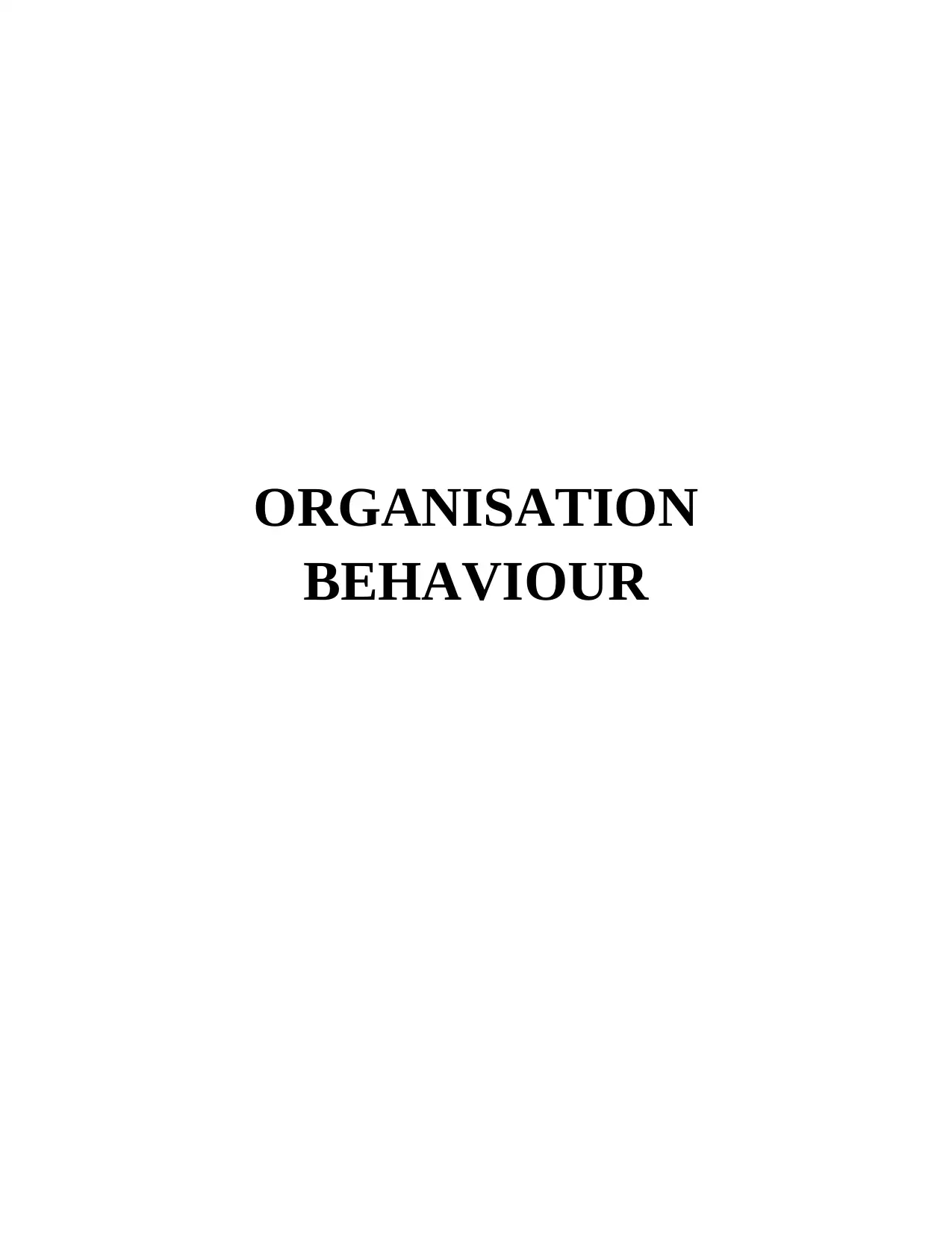
ORGANISATION
BEHAVIOUR
BEHAVIOUR
Paraphrase This Document
Need a fresh take? Get an instant paraphrase of this document with our AI Paraphraser
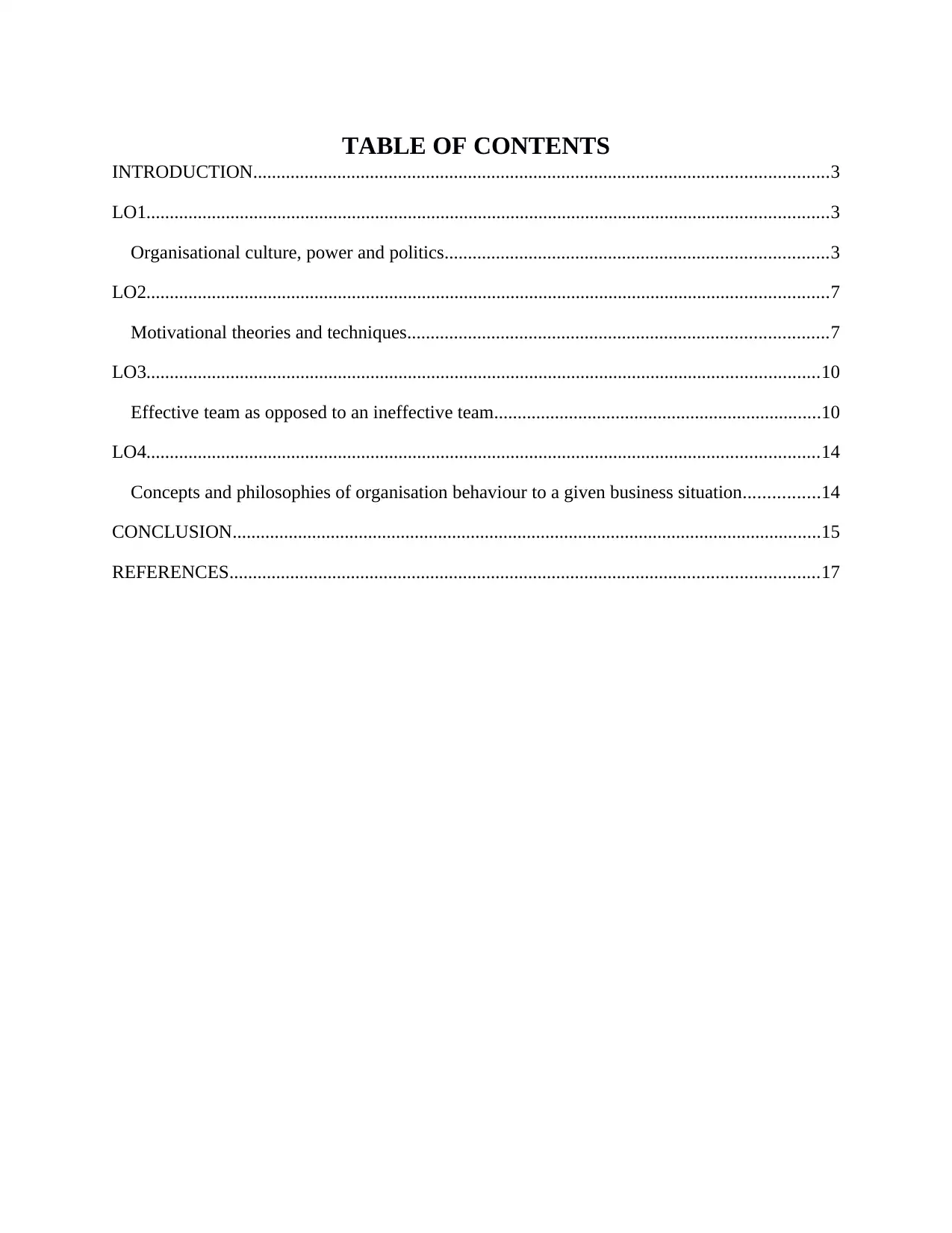
TABLE OF CONTENTS
INTRODUCTION...........................................................................................................................3
LO1..................................................................................................................................................3
Organisational culture, power and politics..................................................................................3
LO2..................................................................................................................................................7
Motivational theories and techniques..........................................................................................7
LO3................................................................................................................................................10
Effective team as opposed to an ineffective team......................................................................10
LO4................................................................................................................................................14
Concepts and philosophies of organisation behaviour to a given business situation................14
CONCLUSION..............................................................................................................................15
REFERENCES..............................................................................................................................17
INTRODUCTION...........................................................................................................................3
LO1..................................................................................................................................................3
Organisational culture, power and politics..................................................................................3
LO2..................................................................................................................................................7
Motivational theories and techniques..........................................................................................7
LO3................................................................................................................................................10
Effective team as opposed to an ineffective team......................................................................10
LO4................................................................................................................................................14
Concepts and philosophies of organisation behaviour to a given business situation................14
CONCLUSION..............................................................................................................................15
REFERENCES..............................................................................................................................17
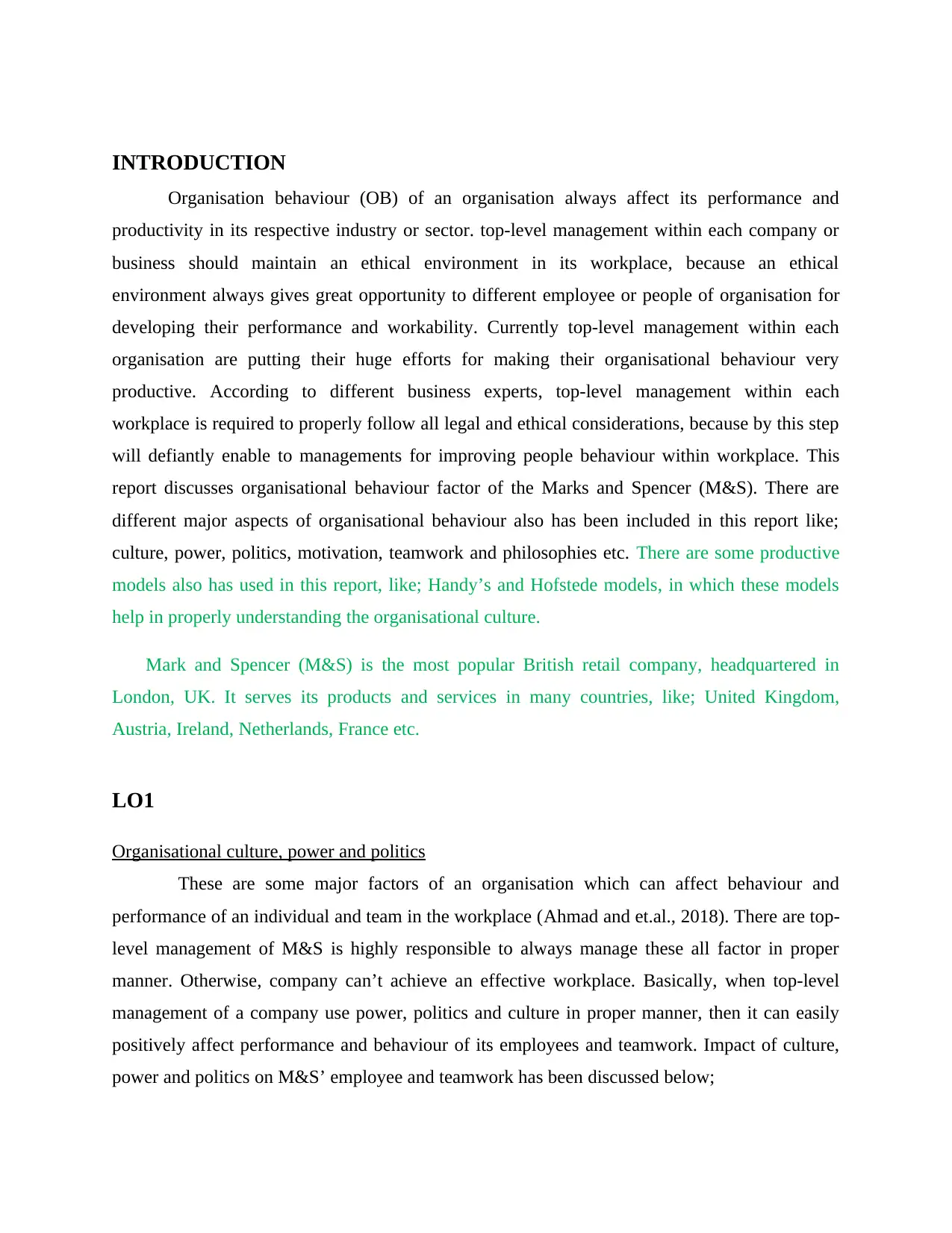
INTRODUCTION
Organisation behaviour (OB) of an organisation always affect its performance and
productivity in its respective industry or sector. top-level management within each company or
business should maintain an ethical environment in its workplace, because an ethical
environment always gives great opportunity to different employee or people of organisation for
developing their performance and workability. Currently top-level management within each
organisation are putting their huge efforts for making their organisational behaviour very
productive. According to different business experts, top-level management within each
workplace is required to properly follow all legal and ethical considerations, because by this step
will defiantly enable to managements for improving people behaviour within workplace. This
report discusses organisational behaviour factor of the Marks and Spencer (M&S). There are
different major aspects of organisational behaviour also has been included in this report like;
culture, power, politics, motivation, teamwork and philosophies etc. There are some productive
models also has used in this report, like; Handy’s and Hofstede models, in which these models
help in properly understanding the organisational culture.
Mark and Spencer (M&S) is the most popular British retail company, headquartered in
London, UK. It serves its products and services in many countries, like; United Kingdom,
Austria, Ireland, Netherlands, France etc.
LO1
Organisational culture, power and politics
These are some major factors of an organisation which can affect behaviour and
performance of an individual and team in the workplace (Ahmad and et.al., 2018). There are top-
level management of M&S is highly responsible to always manage these all factor in proper
manner. Otherwise, company can’t achieve an effective workplace. Basically, when top-level
management of a company use power, politics and culture in proper manner, then it can easily
positively affect performance and behaviour of its employees and teamwork. Impact of culture,
power and politics on M&S’ employee and teamwork has been discussed below;
Organisation behaviour (OB) of an organisation always affect its performance and
productivity in its respective industry or sector. top-level management within each company or
business should maintain an ethical environment in its workplace, because an ethical
environment always gives great opportunity to different employee or people of organisation for
developing their performance and workability. Currently top-level management within each
organisation are putting their huge efforts for making their organisational behaviour very
productive. According to different business experts, top-level management within each
workplace is required to properly follow all legal and ethical considerations, because by this step
will defiantly enable to managements for improving people behaviour within workplace. This
report discusses organisational behaviour factor of the Marks and Spencer (M&S). There are
different major aspects of organisational behaviour also has been included in this report like;
culture, power, politics, motivation, teamwork and philosophies etc. There are some productive
models also has used in this report, like; Handy’s and Hofstede models, in which these models
help in properly understanding the organisational culture.
Mark and Spencer (M&S) is the most popular British retail company, headquartered in
London, UK. It serves its products and services in many countries, like; United Kingdom,
Austria, Ireland, Netherlands, France etc.
LO1
Organisational culture, power and politics
These are some major factors of an organisation which can affect behaviour and
performance of an individual and team in the workplace (Ahmad and et.al., 2018). There are top-
level management of M&S is highly responsible to always manage these all factor in proper
manner. Otherwise, company can’t achieve an effective workplace. Basically, when top-level
management of a company use power, politics and culture in proper manner, then it can easily
positively affect performance and behaviour of its employees and teamwork. Impact of culture,
power and politics on M&S’ employee and teamwork has been discussed below;
⊘ This is a preview!⊘
Do you want full access?
Subscribe today to unlock all pages.

Trusted by 1+ million students worldwide
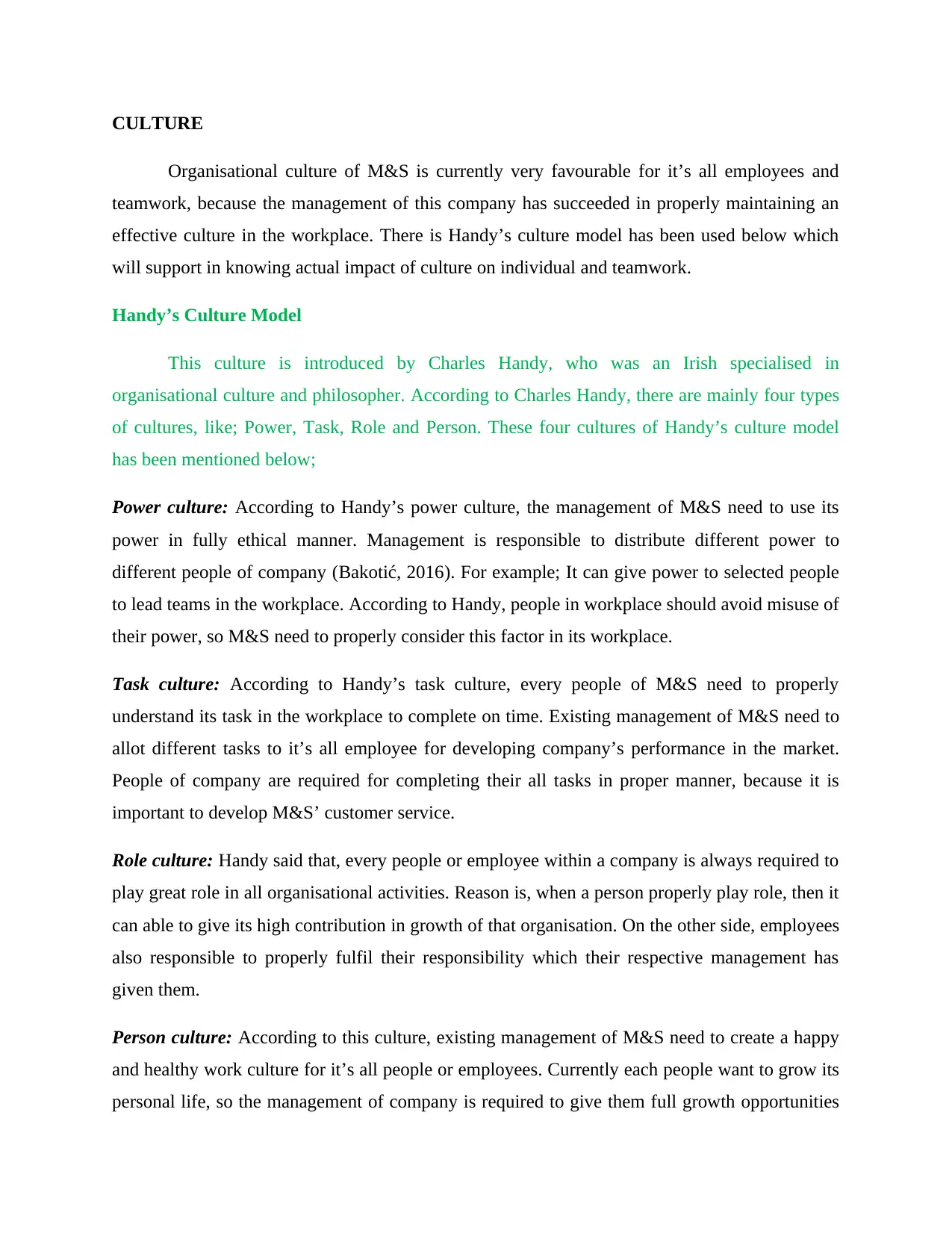
CULTURE
Organisational culture of M&S is currently very favourable for it’s all employees and
teamwork, because the management of this company has succeeded in properly maintaining an
effective culture in the workplace. There is Handy’s culture model has been used below which
will support in knowing actual impact of culture on individual and teamwork.
Handy’s Culture Model
This culture is introduced by Charles Handy, who was an Irish specialised in
organisational culture and philosopher. According to Charles Handy, there are mainly four types
of cultures, like; Power, Task, Role and Person. These four cultures of Handy’s culture model
has been mentioned below;
Power culture: According to Handy’s power culture, the management of M&S need to use its
power in fully ethical manner. Management is responsible to distribute different power to
different people of company (Bakotić, 2016). For example; It can give power to selected people
to lead teams in the workplace. According to Handy, people in workplace should avoid misuse of
their power, so M&S need to properly consider this factor in its workplace.
Task culture: According to Handy’s task culture, every people of M&S need to properly
understand its task in the workplace to complete on time. Existing management of M&S need to
allot different tasks to it’s all employee for developing company’s performance in the market.
People of company are required for completing their all tasks in proper manner, because it is
important to develop M&S’ customer service.
Role culture: Handy said that, every people or employee within a company is always required to
play great role in all organisational activities. Reason is, when a person properly play role, then it
can able to give its high contribution in growth of that organisation. On the other side, employees
also responsible to properly fulfil their responsibility which their respective management has
given them.
Person culture: According to this culture, existing management of M&S need to create a happy
and healthy work culture for it’s all people or employees. Currently each people want to grow its
personal life, so the management of company is required to give them full growth opportunities
Organisational culture of M&S is currently very favourable for it’s all employees and
teamwork, because the management of this company has succeeded in properly maintaining an
effective culture in the workplace. There is Handy’s culture model has been used below which
will support in knowing actual impact of culture on individual and teamwork.
Handy’s Culture Model
This culture is introduced by Charles Handy, who was an Irish specialised in
organisational culture and philosopher. According to Charles Handy, there are mainly four types
of cultures, like; Power, Task, Role and Person. These four cultures of Handy’s culture model
has been mentioned below;
Power culture: According to Handy’s power culture, the management of M&S need to use its
power in fully ethical manner. Management is responsible to distribute different power to
different people of company (Bakotić, 2016). For example; It can give power to selected people
to lead teams in the workplace. According to Handy, people in workplace should avoid misuse of
their power, so M&S need to properly consider this factor in its workplace.
Task culture: According to Handy’s task culture, every people of M&S need to properly
understand its task in the workplace to complete on time. Existing management of M&S need to
allot different tasks to it’s all employee for developing company’s performance in the market.
People of company are required for completing their all tasks in proper manner, because it is
important to develop M&S’ customer service.
Role culture: Handy said that, every people or employee within a company is always required to
play great role in all organisational activities. Reason is, when a person properly play role, then it
can able to give its high contribution in growth of that organisation. On the other side, employees
also responsible to properly fulfil their responsibility which their respective management has
given them.
Person culture: According to this culture, existing management of M&S need to create a happy
and healthy work culture for it’s all people or employees. Currently each people want to grow its
personal life, so the management of company is required to give them full growth opportunities
Paraphrase This Document
Need a fresh take? Get an instant paraphrase of this document with our AI Paraphraser

to develop their employees’ lifestyle (Farris, 2018). At the end, the management of M&S can
easily positively affect performance and behaviour of its employee and teamwork.
Hofstede Model
This model is introduced by Geert Hofstede which is very helpful in properly
understanding organisational culture. This model has involved five factors which has discussed
below;
Power distance: Power distance factor indicates power of different people within the company.
every person within the workplace should ethically use its power.
Masculinity Vs. Femininity: This factor helps in considering efforts of genders within the
workplace. This provides equal growth opportunity to both male and female.
Individualism: This is another major factor which show the value of a person within the
workplace. According to this factor, every employee is important asset to a company.
Uncertainty Avoidance: According to this factor, upper management of company always need to
prepare a systematic plan for dealing organisational uncertainties.
Long Term Orientation: The company should always be prepared for achieving long term goals
which can highly boost its performance within the market.
POWER
Power is another main aspect for the M&S, where top-level management has distributed
various powers to different employee of the company. There is French and Raven’s power types
has been discussed below which will help in understanding impact of power on performance and
behaviour of an employee and teamwork.
French and Raven’s Power Types
According to French and Raven, generally there are five types of power which has been
mentioned below;
easily positively affect performance and behaviour of its employee and teamwork.
Hofstede Model
This model is introduced by Geert Hofstede which is very helpful in properly
understanding organisational culture. This model has involved five factors which has discussed
below;
Power distance: Power distance factor indicates power of different people within the company.
every person within the workplace should ethically use its power.
Masculinity Vs. Femininity: This factor helps in considering efforts of genders within the
workplace. This provides equal growth opportunity to both male and female.
Individualism: This is another major factor which show the value of a person within the
workplace. According to this factor, every employee is important asset to a company.
Uncertainty Avoidance: According to this factor, upper management of company always need to
prepare a systematic plan for dealing organisational uncertainties.
Long Term Orientation: The company should always be prepared for achieving long term goals
which can highly boost its performance within the market.
POWER
Power is another main aspect for the M&S, where top-level management has distributed
various powers to different employee of the company. There is French and Raven’s power types
has been discussed below which will help in understanding impact of power on performance and
behaviour of an employee and teamwork.
French and Raven’s Power Types
According to French and Raven, generally there are five types of power which has been
mentioned below;
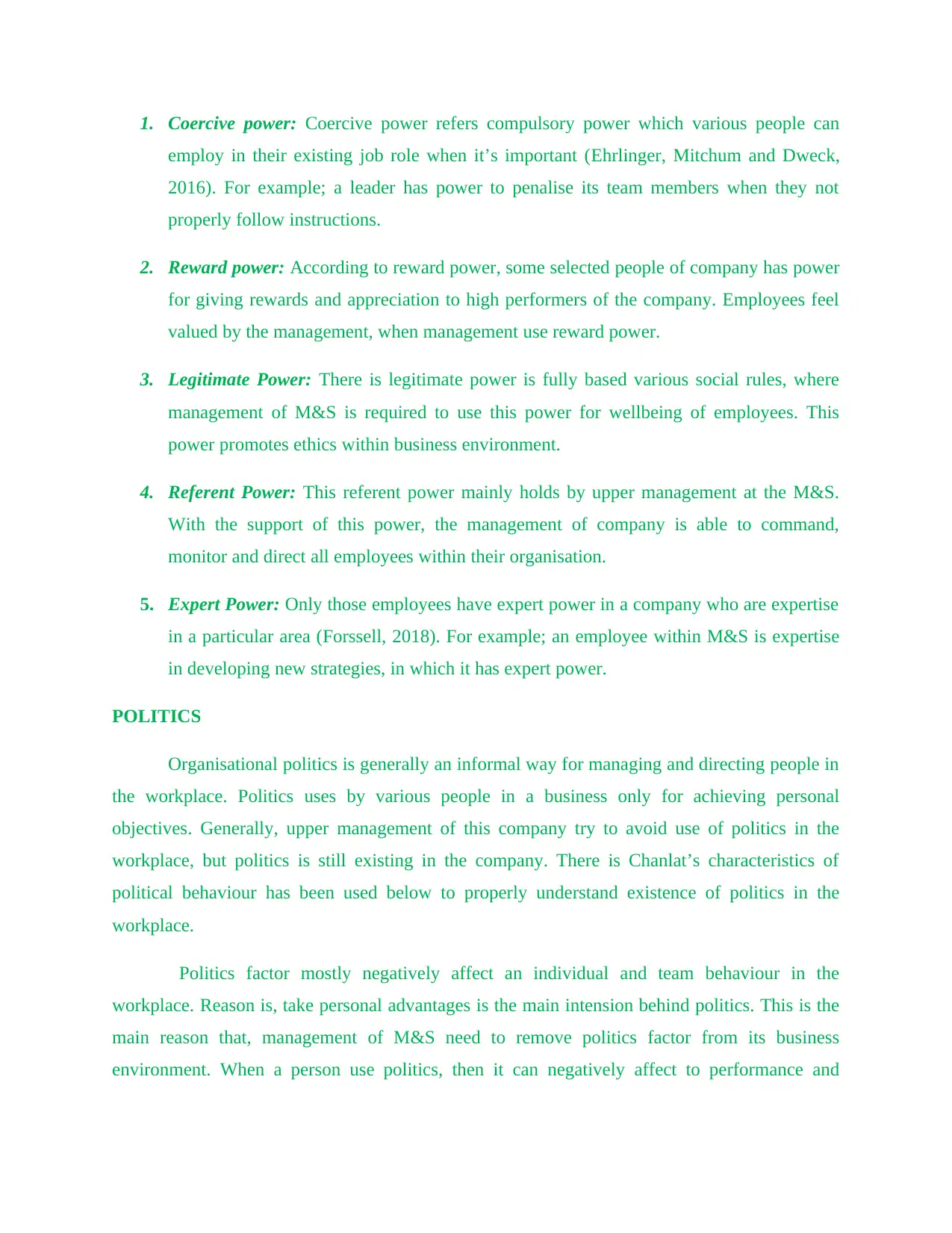
1. Coercive power: Coercive power refers compulsory power which various people can
employ in their existing job role when it’s important (Ehrlinger, Mitchum and Dweck,
2016). For example; a leader has power to penalise its team members when they not
properly follow instructions.
2. Reward power: According to reward power, some selected people of company has power
for giving rewards and appreciation to high performers of the company. Employees feel
valued by the management, when management use reward power.
3. Legitimate Power: There is legitimate power is fully based various social rules, where
management of M&S is required to use this power for wellbeing of employees. This
power promotes ethics within business environment.
4. Referent Power: This referent power mainly holds by upper management at the M&S.
With the support of this power, the management of company is able to command,
monitor and direct all employees within their organisation.
5. Expert Power: Only those employees have expert power in a company who are expertise
in a particular area (Forssell, 2018). For example; an employee within M&S is expertise
in developing new strategies, in which it has expert power.
POLITICS
Organisational politics is generally an informal way for managing and directing people in
the workplace. Politics uses by various people in a business only for achieving personal
objectives. Generally, upper management of this company try to avoid use of politics in the
workplace, but politics is still existing in the company. There is Chanlat’s characteristics of
political behaviour has been used below to properly understand existence of politics in the
workplace.
Politics factor mostly negatively affect an individual and team behaviour in the
workplace. Reason is, take personal advantages is the main intension behind politics. This is the
main reason that, management of M&S need to remove politics factor from its business
environment. When a person use politics, then it can negatively affect to performance and
employ in their existing job role when it’s important (Ehrlinger, Mitchum and Dweck,
2016). For example; a leader has power to penalise its team members when they not
properly follow instructions.
2. Reward power: According to reward power, some selected people of company has power
for giving rewards and appreciation to high performers of the company. Employees feel
valued by the management, when management use reward power.
3. Legitimate Power: There is legitimate power is fully based various social rules, where
management of M&S is required to use this power for wellbeing of employees. This
power promotes ethics within business environment.
4. Referent Power: This referent power mainly holds by upper management at the M&S.
With the support of this power, the management of company is able to command,
monitor and direct all employees within their organisation.
5. Expert Power: Only those employees have expert power in a company who are expertise
in a particular area (Forssell, 2018). For example; an employee within M&S is expertise
in developing new strategies, in which it has expert power.
POLITICS
Organisational politics is generally an informal way for managing and directing people in
the workplace. Politics uses by various people in a business only for achieving personal
objectives. Generally, upper management of this company try to avoid use of politics in the
workplace, but politics is still existing in the company. There is Chanlat’s characteristics of
political behaviour has been used below to properly understand existence of politics in the
workplace.
Politics factor mostly negatively affect an individual and team behaviour in the
workplace. Reason is, take personal advantages is the main intension behind politics. This is the
main reason that, management of M&S need to remove politics factor from its business
environment. When a person use politics, then it can negatively affect to performance and
⊘ This is a preview!⊘
Do you want full access?
Subscribe today to unlock all pages.

Trusted by 1+ million students worldwide
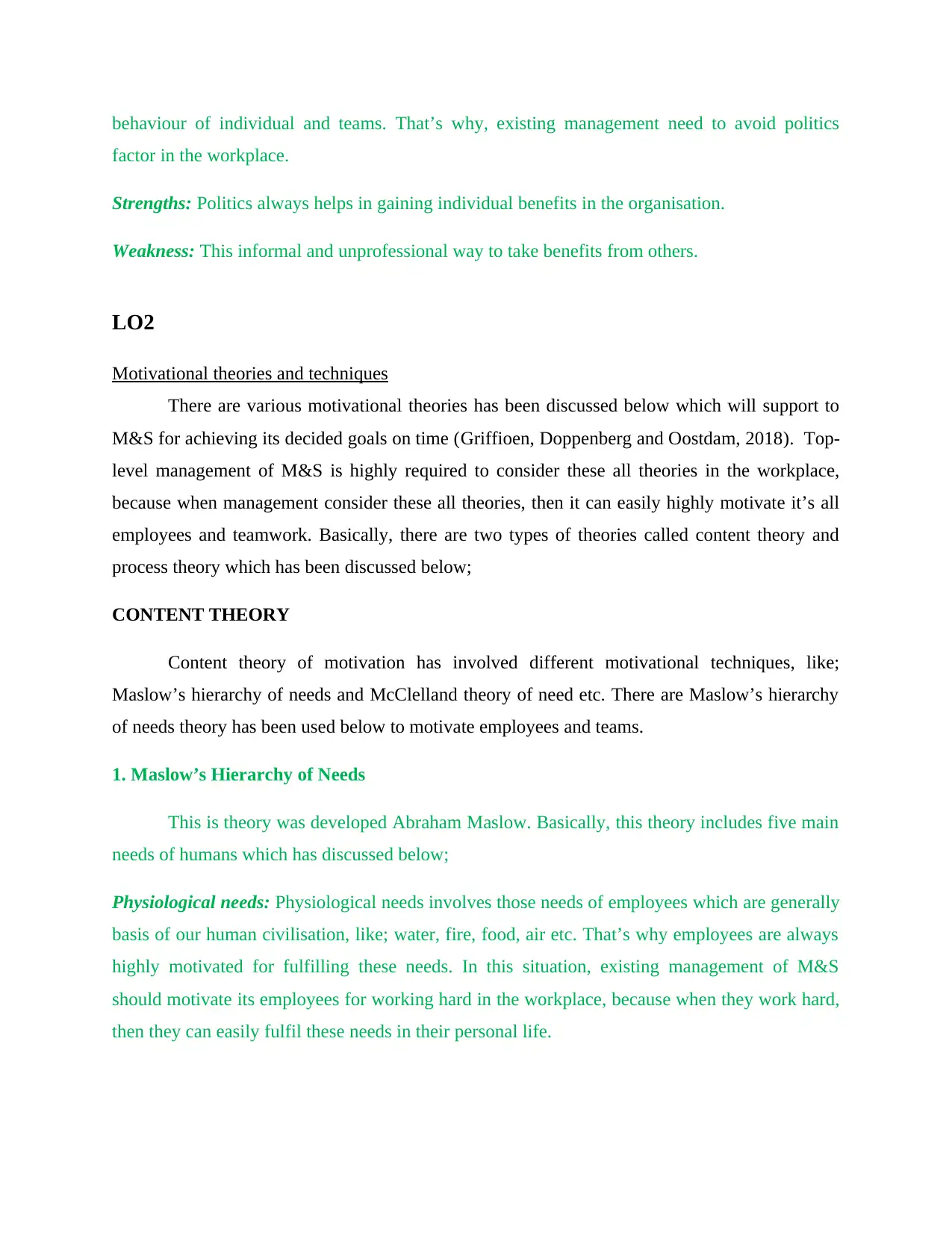
behaviour of individual and teams. That’s why, existing management need to avoid politics
factor in the workplace.
Strengths: Politics always helps in gaining individual benefits in the organisation.
Weakness: This informal and unprofessional way to take benefits from others.
LO2
Motivational theories and techniques
There are various motivational theories has been discussed below which will support to
M&S for achieving its decided goals on time (Griffioen, Doppenberg and Oostdam, 2018). Top-
level management of M&S is highly required to consider these all theories in the workplace,
because when management consider these all theories, then it can easily highly motivate it’s all
employees and teamwork. Basically, there are two types of theories called content theory and
process theory which has been discussed below;
CONTENT THEORY
Content theory of motivation has involved different motivational techniques, like;
Maslow’s hierarchy of needs and McClelland theory of need etc. There are Maslow’s hierarchy
of needs theory has been used below to motivate employees and teams.
1. Maslow’s Hierarchy of Needs
This is theory was developed Abraham Maslow. Basically, this theory includes five main
needs of humans which has discussed below;
Physiological needs: Physiological needs involves those needs of employees which are generally
basis of our human civilisation, like; water, fire, food, air etc. That’s why employees are always
highly motivated for fulfilling these needs. In this situation, existing management of M&S
should motivate its employees for working hard in the workplace, because when they work hard,
then they can easily fulfil these needs in their personal life.
factor in the workplace.
Strengths: Politics always helps in gaining individual benefits in the organisation.
Weakness: This informal and unprofessional way to take benefits from others.
LO2
Motivational theories and techniques
There are various motivational theories has been discussed below which will support to
M&S for achieving its decided goals on time (Griffioen, Doppenberg and Oostdam, 2018). Top-
level management of M&S is highly required to consider these all theories in the workplace,
because when management consider these all theories, then it can easily highly motivate it’s all
employees and teamwork. Basically, there are two types of theories called content theory and
process theory which has been discussed below;
CONTENT THEORY
Content theory of motivation has involved different motivational techniques, like;
Maslow’s hierarchy of needs and McClelland theory of need etc. There are Maslow’s hierarchy
of needs theory has been used below to motivate employees and teams.
1. Maslow’s Hierarchy of Needs
This is theory was developed Abraham Maslow. Basically, this theory includes five main
needs of humans which has discussed below;
Physiological needs: Physiological needs involves those needs of employees which are generally
basis of our human civilisation, like; water, fire, food, air etc. That’s why employees are always
highly motivated for fulfilling these needs. In this situation, existing management of M&S
should motivate its employees for working hard in the workplace, because when they work hard,
then they can easily fulfil these needs in their personal life.
Paraphrase This Document
Need a fresh take? Get an instant paraphrase of this document with our AI Paraphraser
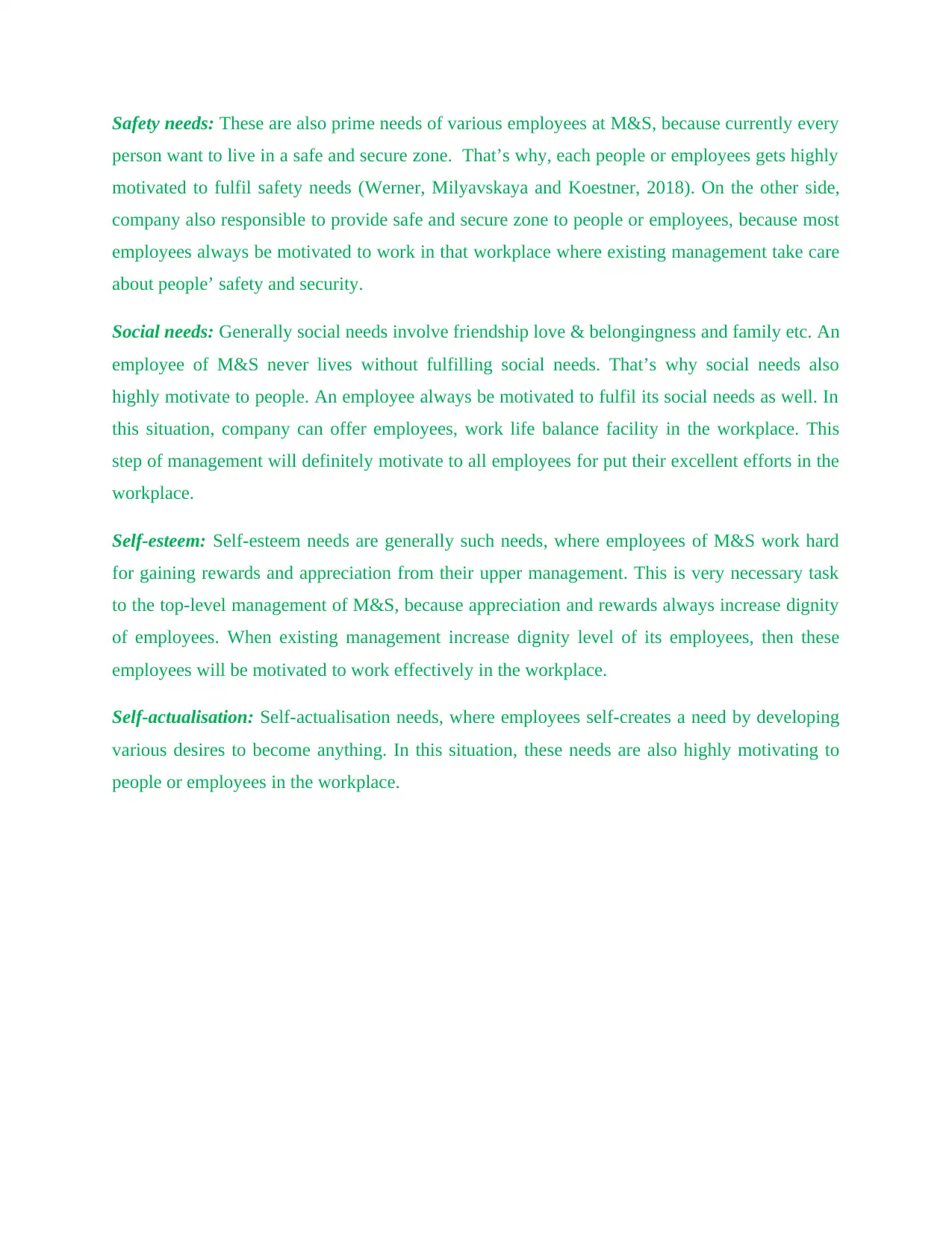
Safety needs: These are also prime needs of various employees at M&S, because currently every
person want to live in a safe and secure zone. That’s why, each people or employees gets highly
motivated to fulfil safety needs (Werner, Milyavskaya and Koestner, 2018). On the other side,
company also responsible to provide safe and secure zone to people or employees, because most
employees always be motivated to work in that workplace where existing management take care
about people’ safety and security.
Social needs: Generally social needs involve friendship love & belongingness and family etc. An
employee of M&S never lives without fulfilling social needs. That’s why social needs also
highly motivate to people. An employee always be motivated to fulfil its social needs as well. In
this situation, company can offer employees, work life balance facility in the workplace. This
step of management will definitely motivate to all employees for put their excellent efforts in the
workplace.
Self-esteem: Self-esteem needs are generally such needs, where employees of M&S work hard
for gaining rewards and appreciation from their upper management. This is very necessary task
to the top-level management of M&S, because appreciation and rewards always increase dignity
of employees. When existing management increase dignity level of its employees, then these
employees will be motivated to work effectively in the workplace.
Self-actualisation: Self-actualisation needs, where employees self-creates a need by developing
various desires to become anything. In this situation, these needs are also highly motivating to
people or employees in the workplace.
person want to live in a safe and secure zone. That’s why, each people or employees gets highly
motivated to fulfil safety needs (Werner, Milyavskaya and Koestner, 2018). On the other side,
company also responsible to provide safe and secure zone to people or employees, because most
employees always be motivated to work in that workplace where existing management take care
about people’ safety and security.
Social needs: Generally social needs involve friendship love & belongingness and family etc. An
employee of M&S never lives without fulfilling social needs. That’s why social needs also
highly motivate to people. An employee always be motivated to fulfil its social needs as well. In
this situation, company can offer employees, work life balance facility in the workplace. This
step of management will definitely motivate to all employees for put their excellent efforts in the
workplace.
Self-esteem: Self-esteem needs are generally such needs, where employees of M&S work hard
for gaining rewards and appreciation from their upper management. This is very necessary task
to the top-level management of M&S, because appreciation and rewards always increase dignity
of employees. When existing management increase dignity level of its employees, then these
employees will be motivated to work effectively in the workplace.
Self-actualisation: Self-actualisation needs, where employees self-creates a need by developing
various desires to become anything. In this situation, these needs are also highly motivating to
people or employees in the workplace.
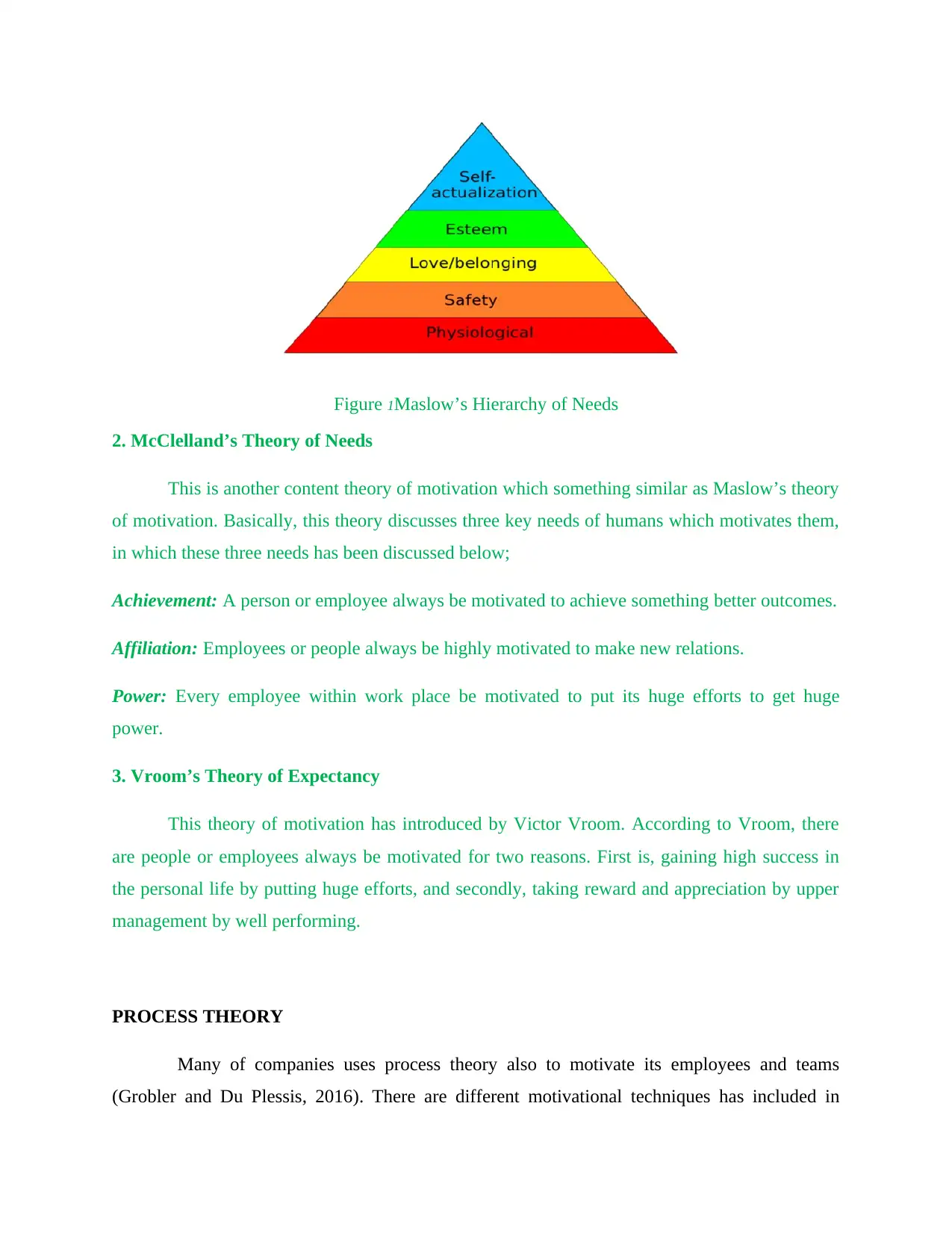
Figure 1Maslow’s Hierarchy of Needs
2. McClelland’s Theory of Needs
This is another content theory of motivation which something similar as Maslow’s theory
of motivation. Basically, this theory discusses three key needs of humans which motivates them,
in which these three needs has been discussed below;
Achievement: A person or employee always be motivated to achieve something better outcomes.
Affiliation: Employees or people always be highly motivated to make new relations.
Power: Every employee within work place be motivated to put its huge efforts to get huge
power.
3. Vroom’s Theory of Expectancy
This theory of motivation has introduced by Victor Vroom. According to Vroom, there
are people or employees always be motivated for two reasons. First is, gaining high success in
the personal life by putting huge efforts, and secondly, taking reward and appreciation by upper
management by well performing.
PROCESS THEORY
Many of companies uses process theory also to motivate its employees and teams
(Grobler and Du Plessis, 2016). There are different motivational techniques has included in
2. McClelland’s Theory of Needs
This is another content theory of motivation which something similar as Maslow’s theory
of motivation. Basically, this theory discusses three key needs of humans which motivates them,
in which these three needs has been discussed below;
Achievement: A person or employee always be motivated to achieve something better outcomes.
Affiliation: Employees or people always be highly motivated to make new relations.
Power: Every employee within work place be motivated to put its huge efforts to get huge
power.
3. Vroom’s Theory of Expectancy
This theory of motivation has introduced by Victor Vroom. According to Vroom, there
are people or employees always be motivated for two reasons. First is, gaining high success in
the personal life by putting huge efforts, and secondly, taking reward and appreciation by upper
management by well performing.
PROCESS THEORY
Many of companies uses process theory also to motivate its employees and teams
(Grobler and Du Plessis, 2016). There are different motivational techniques has included in
⊘ This is a preview!⊘
Do you want full access?
Subscribe today to unlock all pages.

Trusted by 1+ million students worldwide
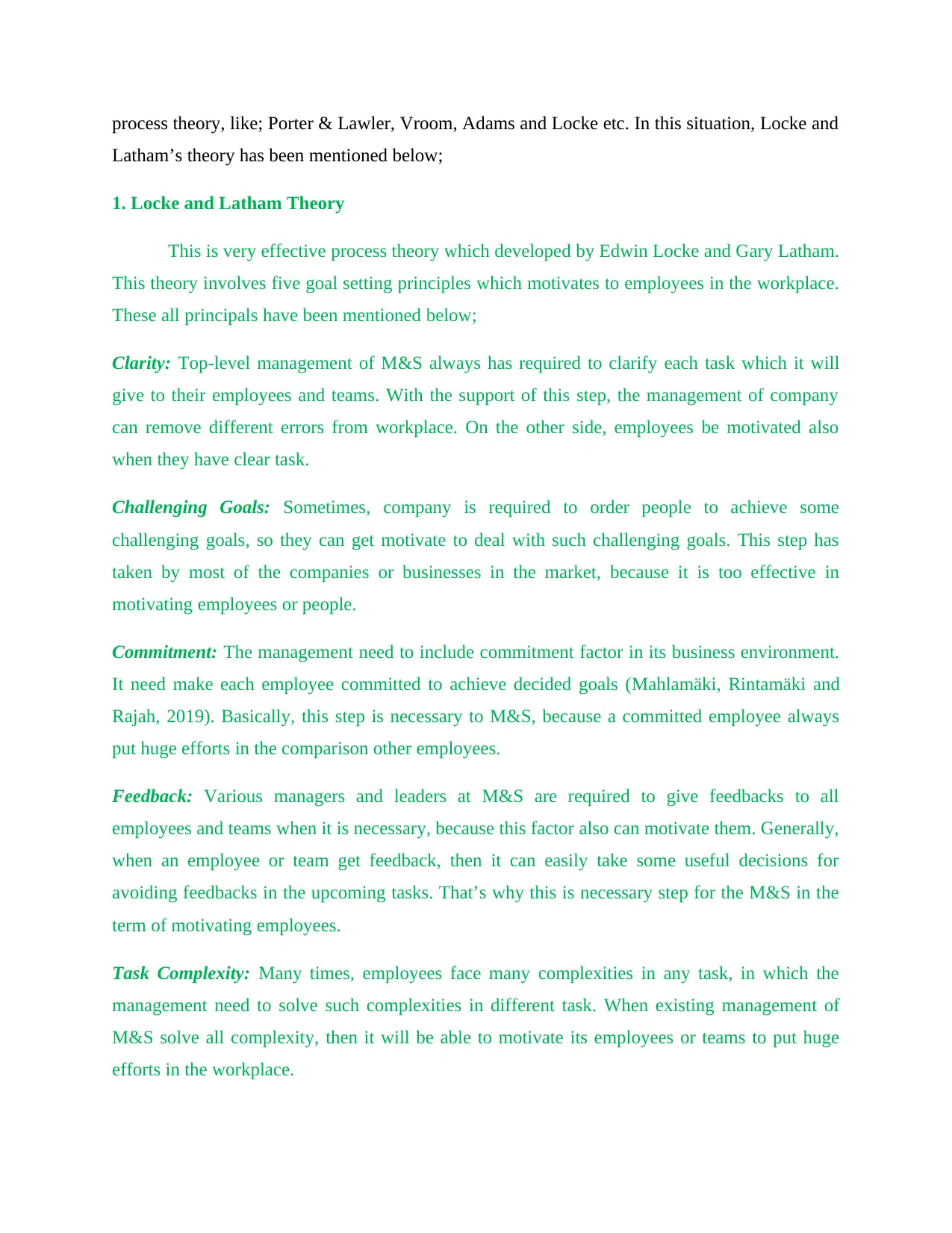
process theory, like; Porter & Lawler, Vroom, Adams and Locke etc. In this situation, Locke and
Latham’s theory has been mentioned below;
1. Locke and Latham Theory
This is very effective process theory which developed by Edwin Locke and Gary Latham.
This theory involves five goal setting principles which motivates to employees in the workplace.
These all principals have been mentioned below;
Clarity: Top-level management of M&S always has required to clarify each task which it will
give to their employees and teams. With the support of this step, the management of company
can remove different errors from workplace. On the other side, employees be motivated also
when they have clear task.
Challenging Goals: Sometimes, company is required to order people to achieve some
challenging goals, so they can get motivate to deal with such challenging goals. This step has
taken by most of the companies or businesses in the market, because it is too effective in
motivating employees or people.
Commitment: The management need to include commitment factor in its business environment.
It need make each employee committed to achieve decided goals (Mahlamäki, Rintamäki and
Rajah, 2019). Basically, this step is necessary to M&S, because a committed employee always
put huge efforts in the comparison other employees.
Feedback: Various managers and leaders at M&S are required to give feedbacks to all
employees and teams when it is necessary, because this factor also can motivate them. Generally,
when an employee or team get feedback, then it can easily take some useful decisions for
avoiding feedbacks in the upcoming tasks. That’s why this is necessary step for the M&S in the
term of motivating employees.
Task Complexity: Many times, employees face many complexities in any task, in which the
management need to solve such complexities in different task. When existing management of
M&S solve all complexity, then it will be able to motivate its employees or teams to put huge
efforts in the workplace.
Latham’s theory has been mentioned below;
1. Locke and Latham Theory
This is very effective process theory which developed by Edwin Locke and Gary Latham.
This theory involves five goal setting principles which motivates to employees in the workplace.
These all principals have been mentioned below;
Clarity: Top-level management of M&S always has required to clarify each task which it will
give to their employees and teams. With the support of this step, the management of company
can remove different errors from workplace. On the other side, employees be motivated also
when they have clear task.
Challenging Goals: Sometimes, company is required to order people to achieve some
challenging goals, so they can get motivate to deal with such challenging goals. This step has
taken by most of the companies or businesses in the market, because it is too effective in
motivating employees or people.
Commitment: The management need to include commitment factor in its business environment.
It need make each employee committed to achieve decided goals (Mahlamäki, Rintamäki and
Rajah, 2019). Basically, this step is necessary to M&S, because a committed employee always
put huge efforts in the comparison other employees.
Feedback: Various managers and leaders at M&S are required to give feedbacks to all
employees and teams when it is necessary, because this factor also can motivate them. Generally,
when an employee or team get feedback, then it can easily take some useful decisions for
avoiding feedbacks in the upcoming tasks. That’s why this is necessary step for the M&S in the
term of motivating employees.
Task Complexity: Many times, employees face many complexities in any task, in which the
management need to solve such complexities in different task. When existing management of
M&S solve all complexity, then it will be able to motivate its employees or teams to put huge
efforts in the workplace.
Paraphrase This Document
Need a fresh take? Get an instant paraphrase of this document with our AI Paraphraser
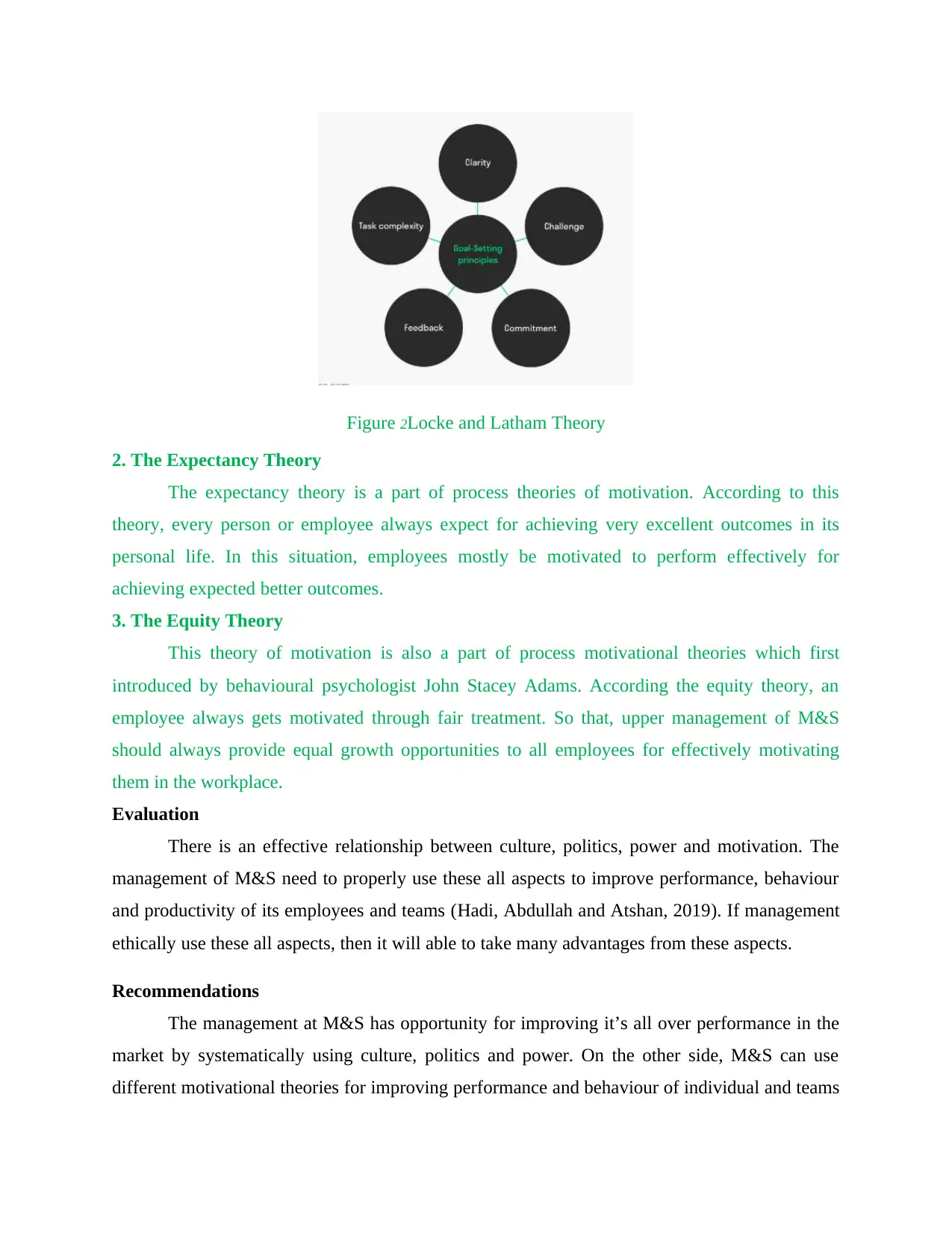
Figure 2Locke and Latham Theory
2. The Expectancy Theory
The expectancy theory is a part of process theories of motivation. According to this
theory, every person or employee always expect for achieving very excellent outcomes in its
personal life. In this situation, employees mostly be motivated to perform effectively for
achieving expected better outcomes.
3. The Equity Theory
This theory of motivation is also a part of process motivational theories which first
introduced by behavioural psychologist John Stacey Adams. According the equity theory, an
employee always gets motivated through fair treatment. So that, upper management of M&S
should always provide equal growth opportunities to all employees for effectively motivating
them in the workplace.
Evaluation
There is an effective relationship between culture, politics, power and motivation. The
management of M&S need to properly use these all aspects to improve performance, behaviour
and productivity of its employees and teams (Hadi, Abdullah and Atshan, 2019). If management
ethically use these all aspects, then it will able to take many advantages from these aspects.
Recommendations
The management at M&S has opportunity for improving it’s all over performance in the
market by systematically using culture, politics and power. On the other side, M&S can use
different motivational theories for improving performance and behaviour of individual and teams
2. The Expectancy Theory
The expectancy theory is a part of process theories of motivation. According to this
theory, every person or employee always expect for achieving very excellent outcomes in its
personal life. In this situation, employees mostly be motivated to perform effectively for
achieving expected better outcomes.
3. The Equity Theory
This theory of motivation is also a part of process motivational theories which first
introduced by behavioural psychologist John Stacey Adams. According the equity theory, an
employee always gets motivated through fair treatment. So that, upper management of M&S
should always provide equal growth opportunities to all employees for effectively motivating
them in the workplace.
Evaluation
There is an effective relationship between culture, politics, power and motivation. The
management of M&S need to properly use these all aspects to improve performance, behaviour
and productivity of its employees and teams (Hadi, Abdullah and Atshan, 2019). If management
ethically use these all aspects, then it will able to take many advantages from these aspects.
Recommendations
The management at M&S has opportunity for improving it’s all over performance in the
market by systematically using culture, politics and power. On the other side, M&S can use
different motivational theories for improving performance and behaviour of individual and teams
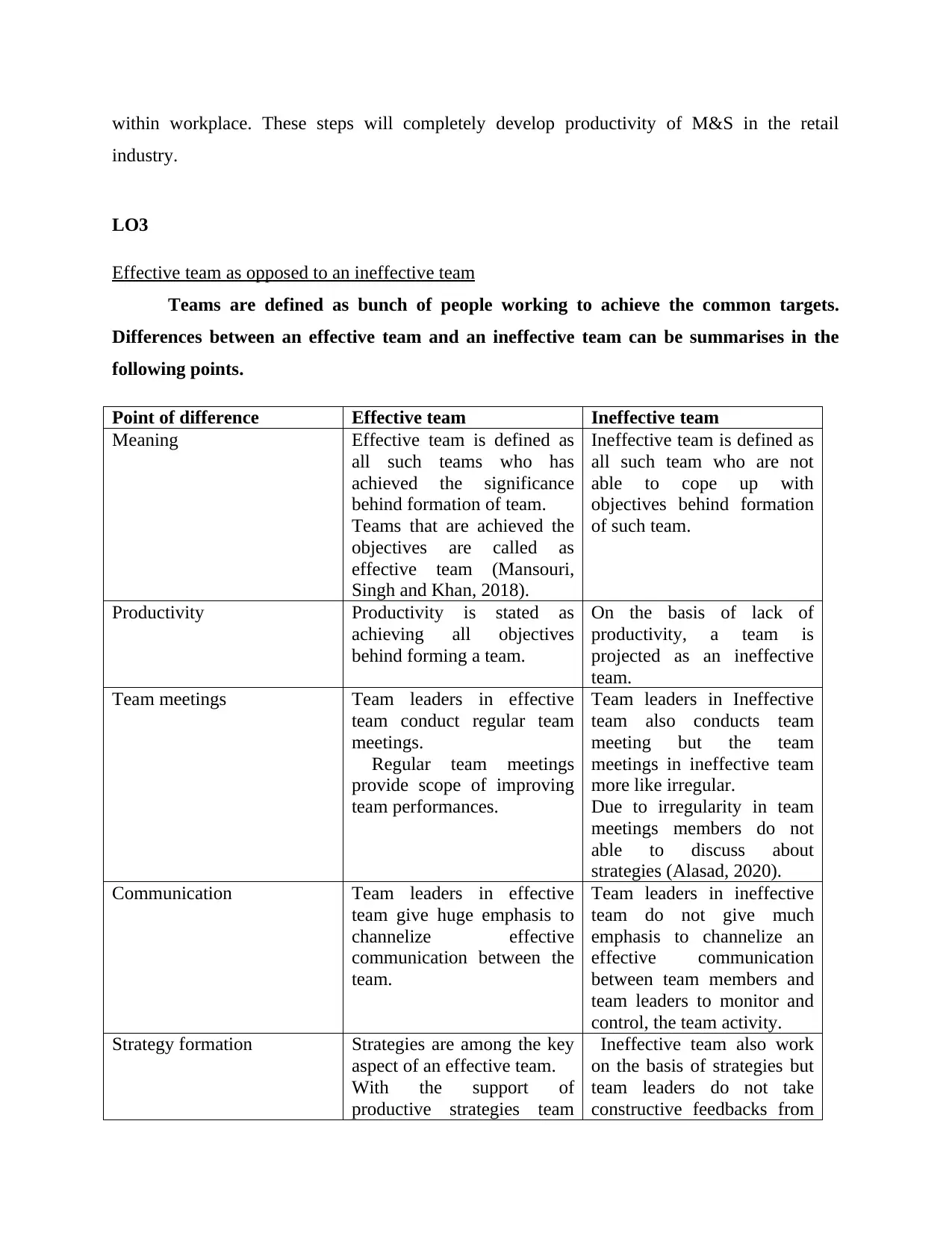
within workplace. These steps will completely develop productivity of M&S in the retail
industry.
LO3
Effective team as opposed to an ineffective team
Teams are defined as bunch of people working to achieve the common targets.
Differences between an effective team and an ineffective team can be summarises in the
following points.
Point of difference Effective team Ineffective team
Meaning Effective team is defined as
all such teams who has
achieved the significance
behind formation of team.
Teams that are achieved the
objectives are called as
effective team (Mansouri,
Singh and Khan, 2018).
Ineffective team is defined as
all such team who are not
able to cope up with
objectives behind formation
of such team.
Productivity Productivity is stated as
achieving all objectives
behind forming a team.
On the basis of lack of
productivity, a team is
projected as an ineffective
team.
Team meetings Team leaders in effective
team conduct regular team
meetings.
Regular team meetings
provide scope of improving
team performances.
Team leaders in Ineffective
team also conducts team
meeting but the team
meetings in ineffective team
more like irregular.
Due to irregularity in team
meetings members do not
able to discuss about
strategies (Alasad, 2020).
Communication Team leaders in effective
team give huge emphasis to
channelize effective
communication between the
team.
Team leaders in ineffective
team do not give much
emphasis to channelize an
effective communication
between team members and
team leaders to monitor and
control, the team activity.
Strategy formation Strategies are among the key
aspect of an effective team.
With the support of
productive strategies team
Ineffective team also work
on the basis of strategies but
team leaders do not take
constructive feedbacks from
industry.
LO3
Effective team as opposed to an ineffective team
Teams are defined as bunch of people working to achieve the common targets.
Differences between an effective team and an ineffective team can be summarises in the
following points.
Point of difference Effective team Ineffective team
Meaning Effective team is defined as
all such teams who has
achieved the significance
behind formation of team.
Teams that are achieved the
objectives are called as
effective team (Mansouri,
Singh and Khan, 2018).
Ineffective team is defined as
all such team who are not
able to cope up with
objectives behind formation
of such team.
Productivity Productivity is stated as
achieving all objectives
behind forming a team.
On the basis of lack of
productivity, a team is
projected as an ineffective
team.
Team meetings Team leaders in effective
team conduct regular team
meetings.
Regular team meetings
provide scope of improving
team performances.
Team leaders in Ineffective
team also conducts team
meeting but the team
meetings in ineffective team
more like irregular.
Due to irregularity in team
meetings members do not
able to discuss about
strategies (Alasad, 2020).
Communication Team leaders in effective
team give huge emphasis to
channelize effective
communication between the
team.
Team leaders in ineffective
team do not give much
emphasis to channelize an
effective communication
between team members and
team leaders to monitor and
control, the team activity.
Strategy formation Strategies are among the key
aspect of an effective team.
With the support of
productive strategies team
Ineffective team also work
on the basis of strategies but
team leaders do not take
constructive feedbacks from
⊘ This is a preview!⊘
Do you want full access?
Subscribe today to unlock all pages.

Trusted by 1+ million students worldwide
1 out of 20
Related Documents
Your All-in-One AI-Powered Toolkit for Academic Success.
+13062052269
info@desklib.com
Available 24*7 on WhatsApp / Email
![[object Object]](/_next/static/media/star-bottom.7253800d.svg)
Unlock your academic potential
Copyright © 2020–2025 A2Z Services. All Rights Reserved. Developed and managed by ZUCOL.





